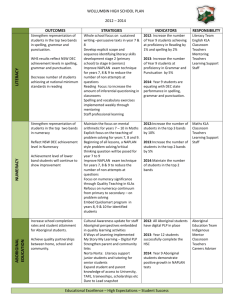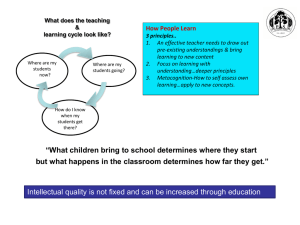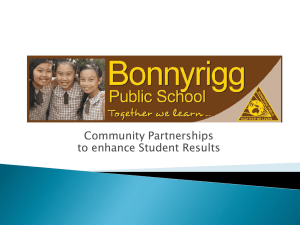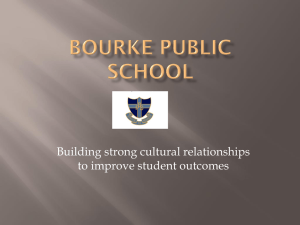ASR 2013 - Broken Hill Public School
advertisement
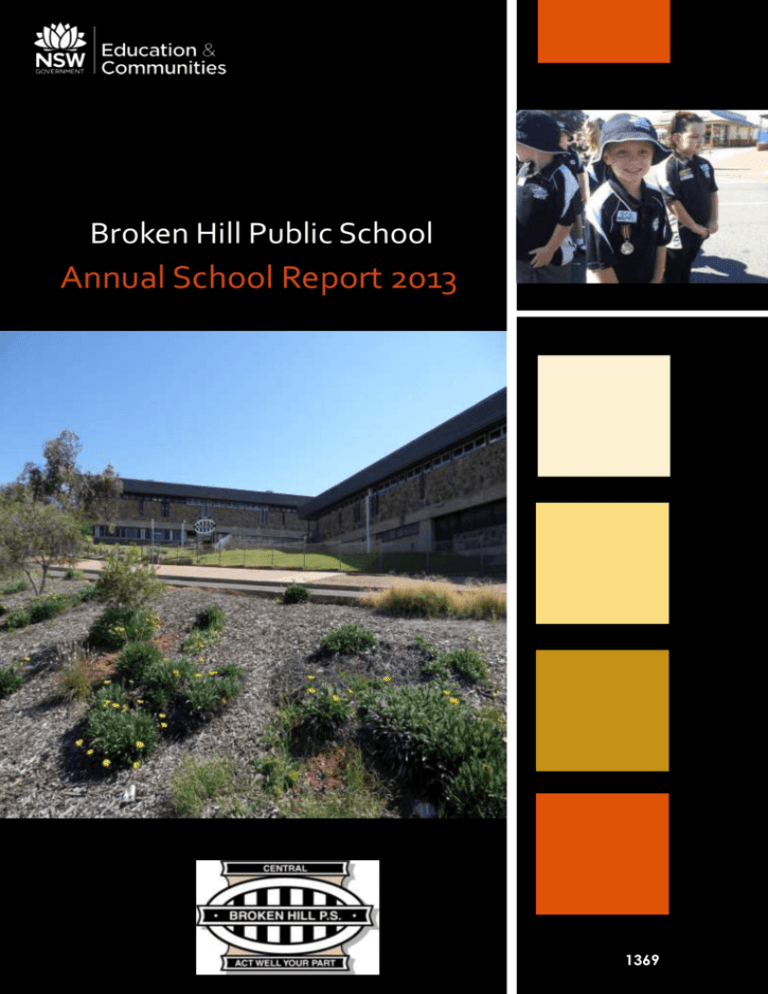
Broken Hill Public School Annual School Report 2013 1369 “I am, You are, We are AWESOME.” Our Catch Cry. We need to remember that being awesome is not just about success. It’s more than just being selected in teams or getting top results it is also about learning new skills, or even just having a go. It’s about setting personal goals and then learning how to ‘kick’ those goals, to know how to loose, how to deal with situations that we may face in our lives. These are positive life long skills that develops a positive self image and that our own awesomness is worthwhile. With the Broken Hill Public School playgroup, preschool, infants and primary, we certainly have a lot to celebrate, being able to provide learning for ages 0 to 12. Lastly I thank the whole school community for your support and dedication to the education of your children, and wish continued joy and success in 2014. School context Broken Hill Public School is a dynamic school located in the far west of NSW. We offer a range of educational opportunities to all students, from our school based playgroup, DEC preschool and across K-6. Our school has high expectations and is an inclusive community. We strive to create a thinking culture that empowers our students to be responsible for their learning and encourage all to strive towards their full potential. Principal’s message We started the year with many changes to staff and in particular, a whole new executive. A little daunting to start, however it was very apparent from the outset that the welcoming nature, generosity, and spirit of the students, staff and parents would help make the transition very smooth. It was extremely pleasing to see the school spirt in action at the many special occasions with in the school, such as the Mother’s Day and Father’s Day Breakfasts, Grandparents Afternoon Tea, Easter Hat Parade, ANZAC Day ceremonies, NAIDOC Week celebrations,just to name a few. These all highlight the school spirit and pride that helps make Broken Hill Public School an enviable place to be. The choirs continue to impress as does the band, creating great opportunities for singers and musicians. Academically, students continue to improve and excel. Programs such as L3, Bridging the Gap, Multilit, Maths Matters, University Competitions and iXtend all contributing to ongoing success. I would like to make particular mention of the school’s involvement in Public Speaking, Verse Speaking, Debating and Premier’s Spelling Bee this year. Once again Broken Hill Public had the highest number of competitors in the Eisteddfod this year taking out 1st and/or 2nd in many events. A tradition that we aim to continue. We had success with public speaking competing in the schools competition. Vince Thompson and Harry Sherrard winning the Broken Hill NAIDOC Competition and then going to Dubbo for the Regional final and placing 3rd, Lewis Jones making the State Final of the Spelling bee in Sydney. Also, recently our debating team were runners-up in the regional debating competition. I certify that the information in this report is the result of a rigorous school self-evaluation process and is a balanced and genuine account of the school’s achievements and areas for development. Michael Fisher P & C and/or School Council message Hello everyone it’s a pleasure to be here although it is also a little sad as this will be the last time I get to be up on stage for the Broken Hill Public School Presentation Day. The P&C have had a great year with activities being undertaken from Term 1 to Term 4. We started the year with a BBQ at the school for a meet and greet with parents and teachers new and old. It was great to be a part of building the community spirit of the school again and I thank Michael and his staff for endeavoring to do this! Very quickly our fundraising started and we had the BBQ going again at the Barrier Swimming Carnival and quickly after the Easter Hat Parade – yes we did see a lot of sausages Term One!! Much thanks to Rob and Joel for their BBQing skills. Over the next three terms we ran the canteen at the Athletics Carnival, had a winter Slice Drive, and BBQ/canteen at the cricket gala. We once again had our big fundraiser for the year with our fun Trivia Night which was a great night for all who attended, and we also had extra special auction items with artworks from each of the classes. We also have the Tea Towels which are also special as they are designed by our very own 1 buddying artists. We have also had the usual business of the uniform shed and the canteen. The uniform shed has had a bit of an overhaul thanks to Heidi and Kylie. The canteen has also had some changes with Leanne going off to have her beautiful boy and we welcomed Janine. Janine has done a fantastic job in picking up the routine of the canteen with a small handover and limited support. I should thank Libby here for all her extra work above her treasurer role. Our fundraising this year has helped with the memorial garden, helped purchase year 6 t-shirts and will go towards the primary school playground. In starting the thank yous for the year I thank the Exec team of the P&C Jodie, Libby and Rob, the volunteers who have helped out at our BBQs and events especially Tanya who came to a meeting or two and ended up with the job of organising this year’s tea-towels. Without your support things wouldn’t get done. I thank the businesses and individuals who donated fantastic goods for prizes and auction items to our Trivia night and thank you to Joel and his crutches who did the hard yards in getting donations. And lastly thank you to all mums and dads, grannies, aunties, pops, uncles and everyone who support our fundraising efforts. As I said at the start this is my last official duty as the President as my baby is off to high school and I must say even though it’s been hard work at times I have had some great fun, met some really fantastic people and generally loved every moment of being part of the Broken Hill Public School community. I wish the incoming executive a great year next year and the school, teachers and students continuing successes under Michael’s leadership. Student representative’s message 2013 was one of the best years that Central school has had. With over $2500 raised by the SRC, various improvements projects were planned for our school including making the infant’s playground better. Seymon Eckert (Girls School Captain) persuaded our Principal, to let everyone wear mufti to the annual Easter Hat Parade, with a letter she wrote. The SRC hosted raffles and guessing competitions associated with numerous community events such as Mother’s Day and Father’s Day breakfasts. The SRC helped with setting up and organising ANZAC Day and Remembrance Day events, while the school captains led these and other assemblies and special gatherings throughout the year. Preschool to Year 2 put on a Christmas Concert for the whole school called Toyland, which everyone loved. The year ended with a great PreschoolYear 6 Presentation Day at the Broken Hill High School Hall. This year at Central was a very busy year, the first for our new Principal Mr Fisher and a very successful and ‘awesome’ year. Angus Walker – School Captain Student information It is a requirement that the reporting of information for all students be consistent with privacy and personal information policies. Student enrolment profile Enrolments Students 300 200 100 Ms Donna K Cruickshank, President P&C 0 2007 2008 2009 2010 2011 2012 2013 Year Male Female Gender Male Female 2 2007 126 96 2008 133 101 2009 129 116 2010 129 103 2011 131 115 2012 122 115 2013 126 108 State DEC Region School Student attendance profile Year K 1 2 3 4 5 6 Total K 1 2 3 4 5 6 Total K 1 2 3 4 5 6 Total 2008 91.7 92.2 94.1 2009 91.0 90.1 93.2 91.2 93.5 94.0 90.1 91.8 92.6 92.1 92.3 92.2 92.4 92.3 92.2 89.9 94.3 93.7 94.0 94.1 94.0 94.0 93.6 92.1 2010 94.8 93.3 90.1 93.9 91.7 90.1 90.3 92.3 92.6 92.3 92.3 92.4 92.4 92.4 92.2 92.4 94.7 94.2 94.4 94.5 94.5 94.4 94.0 94.4 Workforce information 2011 90.4 91.5 92.4 89.7 91.6 91.6 89.1 90.9 92.5 91.9 92.5 92.3 92.3 92.2 92.0 92.2 94.7 94.2 94.2 94.4 94.3 94.2 93.8 94.3 2012 93.8 94.2 92.3 94.5 91.7 93.4 92.7 93.3 92.8 92.2 92.9 93.1 92.8 92.6 92.3 92.7 94.3 93.9 94.2 94.4 94.3 94.2 93.8 94.2 2013 92.0 94.4 92.3 93.1 94.8 88.6 92.1 92.6 93.7 93.2 93.3 93.6 93.5 93.1 93.1 93.4 95.0 94.5 94.7 94.8 94.7 94.5 94.1 94.7 It is a requirement that the reporting of information for all staff must be consistent with privacy and personal information policies. Workforce composition Position Principal Deputy Principal(s) Assistant Principal(s) Head Teachers Classroom Teacher(s) Teacher of Reading Recovery Learning and Support Teacher(s) Teacher Librarian Teacher of ESL School Counsellor School Administrative & Support Staff Total Number 1 0 4 0 8.904 0.5 0.8 0.6 0 0.2 3.622 19.626 The Australian Education Regulation, 2013 requires schools to report on Aboriginal composition of their workforce. Our school supports an indigenous composition of staff and has staff members that identify as Aboriginal or Torres Strait Islander. We had an Aboriginal Education Officer who supported students within classrooms to improve student learning outcomes, funded by National Partnerships Low SES funding in 2013. Management of non-attendance Attendance is managed through our attendance policy/action plan. It is monitored daily and recorded by the class teachers. Teachers regularly check and ask students for notes when returning from a period of absence. Class teachers will always remind students that school is compulsory. Teachers will notify an executive member of staff when a pattern of concern emerges or two consecutive days appear without an explanation for the absence. Office staff will phone parents/carers to achieve early and direct contact. Notes will be sent home if the parent/carer cannot be contacted. If there is no acknowledgement of the first letter within 7 days of the unexplained absence, a second letter will be posted. After another 7 days of unexplained absence, a letter will be posted inviting parents/carers to attend a meeting with the principal to discuss attendance. If there is no response, a formal letter will be sent home advising the parent/carer of their responsibilities and that the student will be referred to the Home School Liaison Officer (HSLO). Teacher qualifications All teaching staff meet the professional requirements for teaching in NSW public schools. Qualifications Degree or Diploma Postgraduate NSW Institute of Teachers Accreditation % of staff 100% 20% 60% Financial summary This summary covers funds for operating costs and does not involve expenditure areas such as permanent salaries, building and major maintenance. Date of financial summary Income Balance brought forward Global funds Tied funds 3 30/11/2013 $ 226658.85 187065.21 306769.83 Key learning areas Excursions Extracurricular dissections Library Training & development Tied funds Casual relief teachers Administration & office School-operated canteen Utilities Maintenance Trust accounts Capital programs Total expenditure Balance carried forward Click on the link http://www.myschool.edu.au and enter the school name in the Find a school and select GO to access the school data. 36029.74 10034.65 51423.60 0.00 817981.88 NAPLAN Year 3 - Literacy (including Reading, Writing, Spelling and Grammar and Punctuation) 13046.28 20457.13 13405.50 3680.30 606.07 206038.88 37338.12 38207.29 0.00 59902.15 15732.06 17312.63 0.00 425726.41 392255.47 Percentage in bands: Year 3 Reading 35 Percentage of students School & community sources Interest Trust receipts Canteen Total income Expenditure Teaching & learning A full copy of the school’s 2013 financial statement is tabled at the annual general meetings of the School Council and/or the parent body. Further details concerning the statement can be obtained by contacting the school. 30 25 20 15 10 5 0 1 2 3 Bands 4 5 6 Percentage in Bands School Average 2009-2013 SSG % in Bands 2013 State DEC % in Bands 2013 School performance 2013 Academic achievements Percentage in bands: Year 3 Writing NAPLAN 40 Percentage of students In the National Assessment Program, the results across the Years 3, 5, 7 and 9 literacy and numeracy assessments are reported on a scale from Band 1 to Band 10. The achievement scale represents increasing levels of skills and understandings demonstrated in these assessments. Year 3: from Band 1 (lowest) to Band 6 (highest for Year 3) 30 20 10 0 1 Year 5: from Band 3 (lowest) to Band 8 (highest for Year 5) 2 3 Bands 4 5 Percentage in Bands School Average 2011-2013 SSG % in Bands 2013 State DEC % in Bands 2013 Year 7: from Band 4 (lowest) to Band 9 (highest for Year 7) Year 9: from Band 5 (lowest) to Band 10 (highest for Year 9) The My School website provides detailed information and data for national literacy and numeracy testing (NAPLAN). 4 6 NAPLAN Year 3 - Numeracy Percentage in bands: Year 3 Spelling Percentage in bands: Year 3 Numeracy 40 25 20 Percentage of students Percentage of students 30 15 10 5 0 1 2 3 Bands 4 5 30 20 10 6 0 Percentage in Bands School Average 2009-2013 SSG % in Bands 2013 State DEC % in Bands 2013 1 3 Bands 4 5 6 Percentage in Bands School Average 2009-2013 SSG % in Bands 2013 State DEC % in Bands 2013 Percentage in bands: Year 3 Grammar & Punctuation NAPLAN Year 5 - Literacy (including Reading, Writing, Spelling and Grammar and Punctuation) 40 Percentage in bands: Year 5 Reading 30 40 20 Percentage of students Percentage of students 2 10 0 1 2 3 Bands 4 5 6 Percentage in Bands School Average 2009-2013 SSG % in Bands 2013 State DEC % in Bands 2013 30 20 10 0 3 4 5 Bands 6 7 Percentage in Bands School Average 2009-2013 SSG % in Bands 2013 State DEC % in Bands 2013 5 8 Percentage in bands: Year 5 Writing Percentage in bands: Year 5 Grammar & Punctuation 40 40 Percentage of students Percentage of students 50 30 20 10 0 3 4 5 6 Bands 7 30 20 10 0 8 3 Percentage in Bands School Average 2011-2013 SSG % in Bands 2013 State DEC % in Bands 2013 4 5 Bands 6 7 8 Percentage in Bands School Average 2009-2013 SSG % in Bands 2013 State DEC % in Bands 2013 NAPLAN Year 5 - Numeracy Percentage in bands: Year 5 Numeracy Percentage of students 40 Percentage in bands: Year 5 Spelling Percentage of students 40 30 20 10 0 3 30 4 5 6 Bands 7 8 Percentage in Bands School Average 20092013 20 Other achievements 10 Academic Children competed in the University of New South Wales Competitions with many outstanding results. Students received a total of 1 High Distinction, 8 Distinctions and 27 Credits. 0 3 4 5 Bands 6 7 8 Percentage in Bands School Average 2009-2013 SSG % in Bands 2013 State DEC % in Bands 2013 Lewis Jones competed in the 2013 Premiers Spelling Bee reaching the State Final in Sydney. 6 participated in Non-PSSA gala days in Rugby League and Golf. Arts Public Speaking, Verse Speaking and debating continue to be a successful focus for Broken Hill Public School. Swimming Broken Hill Public School 2013 champions were: The School Debating Team was runner-up in the Western Debating Challenge. Vince Thompson and Harrison Sherrard won the Broken Hill NAIDOC Public Speaking Challenge then progressing to place third in the Regional Final. Lydia Hinton-Neal – junior girl; Logan Haylett – junior boy; Jaidelyn Ortega-Minear – 11 year girl; Harrison Sherrard – 11 year boy; Broken Hill Public School continues to have the largest number of participants in the Verse Speaking sections of the Broken Hill Eisteddfod, with many placing first and second. Class 1/2H being named 1st Place – Broken Hill Verse Speaking Choirs K-2. France Dutton – senior girl; and Josh Plimer – senior boy champion. Athletics Broken Hill Public School 2013 champions were: Students participated in the Choral Festival and performed at the Broken Hill Eisteddfod. The primary choir won the primary choir section and the infant’s choir placed 2nd. Samantha Finlayson – junior girl; Luke Collins – junior boy; Jade Standley – 11 year girl; Bailey Beattie – 11 year boy; Laylaa Goss – senior girl; and Vince Thompson– senior boy champion Overall Sports Champions 2013 Lydia Hinton-Neal - junior girl; Luke Collins – junior boy; Jaidelyn Ortega-Minear – senior girl; Harrison Sherrard – senior boy; Harrison Sherrard – sportsperson of the year; Sydney Carter – sportsmanship award; and Jonah McCormack – active after school award Sport Students were offered a wide variety of sporting opportunities, programs and competitions. The K-2 classes continued their very successful gross motor and fitness program. Primary students participated in PSSA skill based sport each Friday in Terms 2 and 3 - football, netball, soccer, AFL, cricket, basketball, athletics, swimming and cross country programs and school sport in Terms 1 and 4. The school was also involved in coaching clinics in Rugby League, Basketball, Cricket and Golf. The school also 7 Aboriginal education Significant programs and initiatives Our school is committed to Aboriginal education. Broken Hill Public School Central Preschool Overall, our Indigenous students performed well compared to the state and regional averages. Our school is a P-6 school. We have a wonderful asset with a DEC preschool onsite. Attending our preschool is an exciting opportunity for children to begin their learning journey. Our programs are designed to enhance and facilitate each child’s development and experiences, create enthusiasm for learning and foster a sense of belonging in an innovative early childhood play based setting. Our preschool aims to build success for life by creating community partnerships that explore each child’s potential, provide challenging and quality programs that promote acceptance, diversity and foster values. Being part of the Broken Hill School community also provides the opportunity to foster lifelong learning in a safe and caring environment that caters for individual talents and differences. We have embraced the Early Years Learning Framework (EYLF), the National Quality Framework and truly appreciate parent, caregiver and community participation. We have had continued success with the Bridging the Gap program, providing ongoing support for students in reading. This program was funded by the PSP (Priority Schools Program) and PAS (Priority Action School). In addition, we employed a fulltime Aboriginal Education Officer in semester one and two in 2013 for 4 hours a day through the National Partnership Low SES program. This funding helped continue to support and meet the learning outcomes for all Aboriginal students. In 2013, we continued to implement Personalised Learning Plans (PLPs) for all Aboriginal students, with a commitment to ensure that all students had personalised plans by the end of 2013. We are ensuring all units of work taught have an Aboriginal perspective and that teaching and learning programs reflect the diverse needs of Aboriginal students, developing positive attitudes and understandings about Aboriginal history. The students and staff observe annual indigenous celebrations. Central Playgroup Our playgroup is school based and operated, establishing strong partnerships within our community. We had increased participation with an average of 20 to 30 families attending each week in 2013. Our playgroup operates for 2 hours each week with experienced early childhood staff establishing links between educators, families and children to support and cherish lifelong learning. 8 Multicultural education As a community of schools, we: Broken Hill Public School nominated a staff member to undertake the position of Anti-Racism Contact Officer (ARCO). A small minority of our students are from backgrounds other than English. The school monitors all students closely through assessment, reporting and evaluation and caters for the needs of each individual, working closely with families to form partnerships. School planning and evaluation 2012—2014 National partnerships and significant Commonwealth initiatives (participating schools only) School evaluation processes NSW public schools conduct evaluations to support the effective implementation of the school plan. The processes used include: The school benefited greatly from the programs and strategies under the Low SES National Partnership. The school: joined with other schools to create a partnership mentor to support leadership development programs, provide training in analysis of data, support induction of early career teachers and coordinate professional learning networks. employed additional School Learning Support Officers to continue the Central Playgroup, offering a program for 0-4 year olds. continued Lexia Learning and Lexia Cross Trainer across the school to improve student outcomes in literacy specifically in all aspects of reading; employed an additional staff member to enable team leaders in Early stage 1, Stage 1, Stage 2 and Stage 3, mentoring/coaching teachers, focusing on pedagogy, placing students on the literacy continuum to develop and teach lessons which address the identified needs from NAPLAN; employed an Aboriginal Education Officer for 2012 to work with all Aboriginal students to enhance student learning outcomes and create stronger community partnerships. Staff and Mentoring Meetings are utilized to conduct group analysis and updates of progress of the school plan. School Executive regularly conduct ‘traffic-light’ updates of the progress of targets within the school plan. This is displayed for all staff to monitor their input to the plan. The school community is informed of progress of programs through newsletters and P&C meetings. Planning for the following year takes place with an assessment of programs and initiatives and their impact on the school plan. The effectiveness of the strategies is assessed and targets/priorities are determined. School planning 2012—2014: progress in 2013 purchased resources to compliment the R2L program and resources to support the teaching of literacy across all KLAs (Key Learning Areas) for all stages with an Aboriginal perspective where possible; and School priority 1 Literacy Outcomes from 2012–2014 purchased additional resources for mathematics to enhance and support the teaching of numeracy across all stages. Improve student outcomes in reading and writing with students achieving at or above the expected growth of the region or state. The school also committed funds to enhance teacher quality by: Evidence of progress towards outcomes in 2013: NAPLAN Writing results indicate a growth in 2013 of 25.3 points above the state average. providing professional learning for all K-2 staff in benchmarking, assessment and reporting, Best Start and L3. NAPLAN results in Spelling indicate positive growth of 11.7 points above the state average. 9 NAPLAN results in Grammar and Punctuation indicate a positive growth of 4.9 points above state average. Implement the K-10 numeracy continuum to guide teaching and direct student learning across all stages through stage/team meetings Strategies to achieve these outcomes in 2014 Train a staff member as TOWN (Take Off With Numeracy) facilitator. Continue to implement L3 and Best Start across Early Stage 1 and Stage 1. Implement TOWN within the school in Stages 2 and 3. Provide professional learning for K-2 staff in L3 and Best Start strategies. Implement the development of explicit criteria for teaching writing by developing rubrics and matrices for stages. Explicitly teach identified areas from the Numeracy NAPLAN data (2013) across stages1, 2 and 3 (patterns, 3D, subtraction and division, data, time and multiplication) in 2014. Implement journal writing across all stages. School priority 3 Implement the K-6 literacy continuum to guide teaching and direct student learning across all stages through supervisor meetings. Aboriginal Education Outcomes from 2012–2014 Indigenous students have achieved at or above the national minimum standard using personalised learning plans (PLP’s) driven by data on student performance. Implement L3 and Best Start strategies across all K-2 classes. Maintain the Bridging the Gap (BTG) reading program throughout 2013 to support Stage 2 and 3 Aboriginal students and students performing in the lower bands of NAPLAN and school based assessment, with the BTG coordinator, parent and community tutors. Implement MultiLit program to compliment BTG. Train 2 teachers and volunteers in MultiLit. Evidence of progress towards outcomes in 2013: Extend the implementation of the Lexia Learning and extend students into the Reading Plus program. NAPLAN data indicates that 50% of Indigenous students in Year 3 are at or above national minimum standard in Reading. NAPLAN data indicates that 100% of Indigenous students in Year 3 are at or above national minimum standard in Writing. NAPLAN data indicates that 75% of Indigenous students in Year 3 are at or above national minimum standard in Spelling. NAPLAN data indicates that 75% of Indigenous students in Year 3 are at or above national minimum standard in Grammar and Punctuation. NAPLAN data indicates that 50% of Indigenous students in Year 3 are at or above national minimum standard in Numeracy. NAPLAN data indicates that 50% of Indigenous students in Year 5 are at or above minimum standard in Literacy and Numeracy. School priority 2 Numeracy Outcomes from 2012–2014 Improved student outcomes in numeracy with students achieving at or above the expected growth rate of the region or state Evidence of progress towards outcomes in 2013: NAPLAN data indicates growth in Numeracy exceeds the state average by 12.7 points. Strategies to achieve these outcomes in 2014: Continue the Mathletics interactive program in classrooms and at home access for all families and daily mentals K-6 (oral and written). 10 Strategies to achieve these outcomes in 2014: Develop Personalised Learning Plans (PLP’s) for all Indigenous students. Employ an AEO in 2014 for 0.64 to work with all Aboriginal students to enhance student learning outcomes across K-6 and create stronger community partnerships specifically in the areas of attendance and community consultation. Parent/caregiver, student, and teacher satisfaction In 2013, the school sought the opinions of parents, students and teachers about the school. Their responses are presented below. The vast majority of parents and caregivers believe the school communicates effectively. Parents and Caregivers were given the opportunity to respond to the ways progress and achievement is presented. Families were asked to comment on the provision of Parent/Teachers Progress Interviews at the beginning of term 2 instead of the end of term 1. Parents felt that term 2 provided them with a better understanding of their child’s progress as data was able to be obtained over a longer period of time. Professional learning Professional learning was provided for one staff member in Reading Recovery. Opportunities were provided for learning about the Lexia learning program and Mathletics throughout the year. Best Start training and L3 training was provided for infants staff throughout 2013. Parents and Caregivers were also surveyed as to their preference to the time of day for the annual Presentation of Awards. Families were asked to choose between the traditional night ceremony or a day-time ceremony. All staff participated in collaborative stage based planning days, focusing on the NSW syllabus for the Australian Curriculum. Three teaching staff accessed and completed modules from the online Classroom Teachers program. 70% of families preferred the day ceremony. Several comments were put forward to consider a twilight presentation ceremony. Training in MultiLit was provided to staff and volunteers for inclusion in class programs and with the Bridging the Gap Program. The choice of Presentation Day ceremony was well supported with approximately 300 people in attendance. One teacher attended multiple training workshops on the Targeted Early Numeracy Intervention (TENs) program, with the district numeracy leader visiting for lesson observation, mentoring and instruction. All staff was provided training in the Every Student, Every School framework. Providing guidance for teachers targeting the needs of individual students. Teachers were provided opportunities for training and development in sports coaching in a variety of sports. One teacher participated in the AustSwim Course. 11 About this report In preparing this report, the self-evaluation committee has gathered information from evaluations conducted during the year and analysed other information about the school's practices and student learning outcomes. The self-evaluation committee and school planning committee have determined targets for the school's future development. Michael Fisher, Principal Peter Dougherty, Assistant Principal Jonathon Thomas, Assistant Principal Leona Slater, Aboriginal Education Officer Trudy Jessett, School Admin Manager/Parent Rep. School contact information Broken Hill Public School Mica Street (PO Box 33) Broken Hill NSW 2880 Ph: 08 8087 3522 Fax: 08 8087 3903 Email: brokenhill-p.school@det.nsw.edu.au Web: www.brokenhillpublicschool.com.au School Code: 1369 Parents can find more information about Annual School Reports, how to interpret information in the report and have the opportunity to provide feedback about the report at: https://detwww.det.nsw.edu.au/highperformance/annual-school-reports 12
